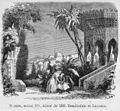
Honoré-Victorin Daumier was a French painter, sculptor, and printmaker, whose many works offer commentary on the social and political life in France, from the Revolution of 1830 to the fall of the second Napoleonic Empire in 1870. He earned a living producing caricatures and cartoons in newspapers and periodicals such as La Caricature and Le Charivari, for which he became well known in his lifetime and is still remembered today. He was a republican democrat, who satirized and lampooned the monarchy, politicians, the judiciary, lawyers, the bourgeoisie, as well as his countrymen and human nature in general.

Théodore Chassériau was a Dominican-born French Romantic painter noted for his portraits, historical and religious paintings, allegorical murals, and Orientalist images inspired by his travels to Algeria. Early in his career he painted in a Neoclassical style close to that of his teacher Jean-Auguste-Dominique Ingres, but in his later works he was strongly influenced by the Romantic style of Eugène Delacroix. He was a prolific draftsman, and made a suite of prints to illustrate Shakespeare's Othello. The portrait he painted at the age of 15 of Prosper Marilhat makes Chassériau the youngest painter exhibited at the Louvre museum.

Joseph Méry was a French writer, journalist, novelist, poet, playwright and librettist.

Félix Henri Bracquemond was a French painter, etcher, and printmaker. He played a key role in the revival of printmaking, encouraging artists such as Édouard Manet, Edgar Degas and Camille Pissarro to use this technique.

Jules-Adenis de Colombeau was a 19th-century French opera librettist, playwright, and journalist.

Marie Bracquemond was a French Impressionist artist. She was one of four notable women in the Impressionist movement, along with Mary Cassatt (1844–1926), Berthe Morisot (1841–1895), and Eva Gonzalès (1847–1883). Bracquemond studied drawing as a child and began showing her work at the Paris Salon when she was still an adolescent. She never underwent formal art training, but she received limited instruction from Jean-Auguste-Dominique Ingres (1780–1867) and advice from Paul Gauguin (1848–1903) which contributed to her stylistic approach.
Julien Vallou de Villeneuve was a French painter, lithographer and photographer.

Claude Auguste Lamy was a French physicist and chemist chemist who discovered the element thallium independently from William Crookes in 1862; as a result, they are considered co-discoverers, although they did not collaborate.

François Antoine Maxime Lalanne was a French artist known for his etchings and charcoal drawings (fusain).

Baron Charles Frédéric Chassériau du Chiron was a Saint Dominican architect and painter, who served as chief architect of the cities of Marseille, Algiers, in Algeria; and Cairo, in Egypt. He is particularly known for having designed the seafront of the city of Algiers.

Jean Baptiste Auguste Vinchon was a French painter.

Angélique Mezzara, born Marie Angélique Foulon, was a French portrait painter and miniaturist, who frequently worked in pastels. During a time when few women were painters, she exhibited regularly for nearly 30 years at the Paris Salon, the major art event of the time. Two of her sons became sculptors, and a daughter exhibited with her at the Paris exhibition as a painter.
Fernand Desnoyers, full name Félix-Emile-Arthur Desnoyers, was a 19th-century French writer and literary critic.

Louis Michel Halbou (1730–1809) was a French draughtsman and engraver of the pre-Romantic period, specialising in burin. His work can be found in several public collections such as the Edmond de Rothschild prints collection in the Louvre, the Musée du château de Versailles et du Trianon, the Art Institute of Chicago and the Wellcome Trust.

The Maison pompéienne, sometimes called the Palais pompéien was the hôtel particulier of Prince Jérôme Napoléon in Paris in the style of the Villa of Diomedes in Pompeii. It was located at 16-18 Avenue Montaigne from 1860 to 1891.

Paul-Alfred Parent de Curzon was a French painter, known for his genre scenes and landscapes with figures.
Louise Astoud-Trolley was a French sculptor and painter.

Estelle de Barescut was a French painter and lithographer. She exhibited her lithographs at the Salon de Paris in 1834 and 1835, and her paintings from 1842 to 1851.

Arab Chiefs Challenging each other to Single Combat under the Ramparts of a City(French: Chefs de tribus arabes se défiant au combat singulier, sous les remparts d'une ville) is an oil painting on canvas executed in 1852 by the French painter Théodore Chassériau. It was one of three works by Chassériau accepted for the 1852 Salon. It is held at the Musée d'Orsay, in Paris.

Jules Frédéric Ballavoine (1842–1914) was a French painter and draughtsman. He painted portraits, landscapes, genre and historical scenes and nudes. According to the Benezit Dictionary of Artists, "He painted conventional historical themes, but his genre painting is freer and more intimate in style."























